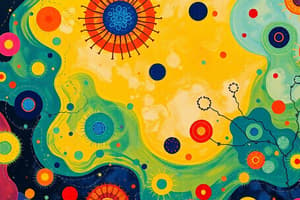Podcast
Questions and Answers
What are protists?
What are protists?
Eukaryotes that cannot be classified as animals, plants, or fungi.
What is a protozoan?
What is a protozoan?
An animal-like protist that is a heterotroph and can move to obtain food.
What is a pseudopod?
What is a pseudopod?
Temporary bulges of the cell, also known as a false foot.
What is a contractile vacuole?
What is a contractile vacuole?
What are cilia?
What are cilia?
What is symbiosis?
What is symbiosis?
What is mutualism?
What is mutualism?
What are algae?
What are algae?
What are pigments?
What are pigments?
What is an algal bloom?
What is an algal bloom?
What is a red tide?
What is a red tide?
What is eutrophication?
What is eutrophication?
List the four types of animal-like protists and tell how each type moves.
List the four types of animal-like protists and tell how each type moves.
How are protozoans similar to animals?
How are protozoans similar to animals?
An animal-like protist is observed under a microscope which lacks cilia or flagella and moves by forming temporary bulges of cytoplasm. How would you classify this protist?
An animal-like protist is observed under a microscope which lacks cilia or flagella and moves by forming temporary bulges of cytoplasm. How would you classify this protist?
In what way are diatoms, dinoflagellates, euglena, and other plant-like protists similar to plants?
In what way are diatoms, dinoflagellates, euglena, and other plant-like protists similar to plants?
Why is sunlight important to plant-like protists?
Why is sunlight important to plant-like protists?
Would you classify Euglena as a plant-like protist or an animal-like protist? Explain.
Would you classify Euglena as a plant-like protist or an animal-like protist? Explain.
What are the three types of fungus-like protists?
What are the three types of fungus-like protists?
In what ways are fungus-like protists similar to fungi?
In what ways are fungus-like protists similar to fungi?
In what environments are water molds found?
In what environments are water molds found?
What color pigments do brown algae contain?
What color pigments do brown algae contain?
What is symbiosis?
What is symbiosis?
What are cilia?
What are cilia?
In what environment do all protists live?
In what environment do all protists live?
What are Sarcodines?
What are Sarcodines?
In what kinds of environments do amoebas live?
In what kinds of environments do amoebas live?
Which traits are shared by all protists?
Which traits are shared by all protists?
What are the diverse protist categories?
What are the diverse protist categories?
What major characteristic would you expect a plant-like protist to have?
What major characteristic would you expect a plant-like protist to have?
What are some animal-like traits of protozoans?
What are some animal-like traits of protozoans?
What name is given to animal-like protists?
What name is given to animal-like protists?
What name is given to plant-like protists?
What name is given to plant-like protists?
How are protozoans different from animals?
How are protozoans different from animals?
What major characteristic is used to classify protozoans?
What major characteristic is used to classify protozoans?
What do the animal-like protists, known as protozoans: Amoeba & Paramecium have in common?
What do the animal-like protists, known as protozoans: Amoeba & Paramecium have in common?
Flashcards are hidden until you start studying
Study Notes
Protists Overview
- Protists are eukaryotic organisms that do not fit into the categories of animals, plants, or fungi.
- They inhabit mostly moist environments and exhibit a wide diversity in form and function.
Types of Protists
- Protozoans: Considered animal-like protists; they are heterotrophic and can move actively to obtain food.
- Algae: Plant-like protists that can perform photosynthesis and possess chlorophyll.
- Fungus-like Protists: Include slime molds, water molds, and downy mildew.
Protozoan Characteristics
- Move by various means such as pseudopods (e.g., amoeba), cilia (e.g., paramecium), or flagella (e.g., giardia), and some are parasitic (e.g., Plasmodium).
- Heterotrophic nature mimics traits of animals; however, they are unicellular, unlike multicellular animals.
Key Structures
- Pseudopod: A temporary cell extension used for movement and feeding.
- Contractile Vacuole: A structure that regulates water balance by collecting and expelling excess water.
- Cilia: Hairlike projections that aid in locomotion through wave-like movements.
Relationships Among Organisms
- Symbiosis: A close relationship between two species that benefits at least one organism.
- Mutualism: A specific form of symbiosis where both organisms benefit.
Algal Growth Phenomena
- Algal Bloom: Rapid increase in algal populations in aquatic environments, often triggered by nutrient input.
- Eutrophication: The buildup of nutrients like nitrogen and phosphorus in bodies of water, leading to increased algal growth.
- Red Tide: A type of algal bloom that occurs in saltwater, coloring the water and possibly causing harm to marine life.
Plant-Like Protists
- Autotrophic in nature, meaning they can produce their own food through photosynthesis.
- Pigments present in these organisms give them varied colors; brown algae, for instance, contain brown, green, yellow, and orange pigments.
Distinguishing Features
- Fungus-like Protists: Share common traits with fungi, such as being heterotrophic and having cell walls made of chitin.
- Unique Characteristics: Protists are classified based on their movement, nutrition, and habitat specifics, such as moisture levels.
Environment and Habitats
- Moist Environments: All protists require wet conditions for survival, whether in freshwater, saltwater, or damp terrestrial locations.
Shared Traits of Protists
- All protists are eukaryotic cells characterized by a cellular structure that includes a nucleus and other organelles.
Summary of Classifications
- Protozoans and Algae: Classified by their nutritional modes (heterotrophic vs. autotrophic).
- Major Differences from Animals: Protozoans are unicellular, in contrast to the multicellular structure of animals.
Common Traits Among Protozoans
- Both amoeba and paramecium share fundamental cellular functions, such as nutrient uptake through eating similar organisms, and the presence of nuclei and vacuoles for maintaining cellular processes.
Studying That Suits You
Use AI to generate personalized quizzes and flashcards to suit your learning preferences.




